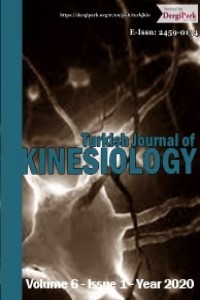Evaluation of agility and acceleration levels in male and female futsal players
Evaluation of agility and acceleration levels in male and female futsal players
Acceleration, Agility Futsal.,
___
- Ali, A., Williams, C., Hulse, M., Strudwick, A., Reddin, J., Howarth, L., & McGregor, S. (2007). Reliability and validity of two tests of soccer skill. J Sport Sci, 25(13), 1461-1470.
- Başkaya, G., Ünveren, A., & Karavelioğlu, M. B. (2018). Comparison of some physiological and motoric characteristics of female soccer and futsal players. Niğde University Journal of Physical Education and Sport Sciences, 12(1), 12-20.
- Bekesi, A., Szalay, B., Bakos, C. Z., Oláh, A., Boncz, I., Kiss, N., & Pakai, A. (2020). PMS58 The examination and development of the agility skills in county first-class soccer players. Value in Health, 23, S602.
- Brown T. (2009). Speed and agility: what defines them and how to train for both. Performance Training Journal. 8(4), 12.
- Çakır, E. (2019). Investigation of female soccer players performance values based on ambient temperature. Universal Journal of Educational Research, 7(1), 239-243.
- Cloak, R., Nevill, A., Smith, J., & Wyon, M. (2014). The acute effects of vibration stimulus following FIFA 11+ on agility and reactive strength in collegiate soccer players. J Sport Health Sci, 3(4), 293-298.
- Eniseler N. (2010). Bilimin ışığında futbol antrenmanı. (6. Edition). İzmir: Birleşik Matbaacılık. (In Turkish).
- Galy, O., Zongo, P., Chamari, K., Chaouachi, A., Michalak, E., Dellal, A., Castagna, C., & Hue, O. (2015). Anthropomet¬ric and physiological characteristics of Melanesian futsal players: A first approach to talent identification in Oceania. Biol Sport, 32(2), 135-141.
- Goncalves, J. T. (1998). The principles of Brazilian soccer. Reedswain Inc..
- Güven, F., Aktas, S., & Kocaoglu, Y. (2022). The relationship between agility and acceleration in football. National Journal of Kinesiology, 2(2), 21-26.
- Herman, I., Hasan, M. F., Hidayat, I. I., & Apriantono, T. (2020). Analysis of speed and acceleration on 60-meters running test between women soccer and futsal players. In 4th International Conference on Sport Science, Health, and Physical Education (ICSSHPE 2019) (pp. 345-347). Atlantis Press.
- Little, T., & Williams, A. G. (2005). Specificity of acceleration, maximum speed, and agility in professional soccer players. J Strength Cond Res, 19(1), 76–78.
- Lockie, R. G., Schultz, A. B., Callaghan, S. J., Jeffriess, M. D., & Berry, S. P. (2013). Reliability and validity of a new test of change-of-direction speed for field-based sports: the change-of direction and acceleration test (CODAT). J Sports Sci Med. 12(1), 88.
- Markovic, G., Jukic, I., Milanovic, D., Metikos, D. (2007). Effects of sprint and plyometric training on muscle function and athletic performance. J Strength Cond Res, 21(2), 543-549.
- Matos, J. A. B., Aidar, F. J., Mendes, R. R., Lômeu, L. M., Santos, C. A, Pains, R., Silva, C. A., & Reis, V. M. (2008). Acceleration capacity in futsal and soccer players. Fitness & Performance Journal, 7(4), 224-228.
- Milanović, Z., Sporiš, G., Trajković, N., & Fiorentini, F. (2011). Differences in agility performance between futsal and soccer players. Sport Sci, 4(2), 55-59.
- Naser, N., Ali, A., & Macadam, P. (2017). Physical and physiological demands of futsal. J Exerc Sci Fit, 15(2), 76-80.
- Nauright, J. (Ed.). (2012). Sports around the World: History, Culture, and Practice [4 volumes]. Retrieved from http://publisher.abc-clio.com/9781598843019
- Ortega, J. A. F., De los Reyes, Y. G., & Pena, F. R. G. (2020). Effects of strength training based on velocity versus traditional training on muscle mass, neuromuscular activation, and indicators of maximal power and strength in girls soccer players. Apunts Sports Medicine, 55(206), 53-61.
- Pauole, K., Madole, K., Garhammer, J., Lacourse, M., & Rozenek, R. (2000). Reliability and validity of the T-test as a measure of agility, leg power, and leg speed in college-aged men and women. J Strength Cond Res, 14(4), 443-450.
- Pavillon, T., Tourny, C., Aabderrahman, A. B., Salhi, I., Zouita, S., Rouissi, M., ... Zouhal, H. (2021). Sprint and jump performances in highly trained young soccer players of different chronological age: Effects of linear. Change–of–direction sprint training. J Exerc Sci Fit, 19(2), 81-90.
- Picanco, L. M., Rodrigues Silva, J. J., & Del Vecchio, F. B. (2012). Relationship between strength and agility in futsal players. Revista Brasileira de Futsal e Futebol, 4(12).
- Rampinini, E., Impellizzeri, FM., Castagna, C., Coutts, AJ., Wisløff, U. (2001) Technical performance during soccer matches of the Italian Serie A league: effect of fatigue and competitive level. J Sci Med Sport. 2(1):227-33.
- Roxburgh, A. (2008). The Technician Futsal: Newsletter for Coaches. Nyon: UEFA.
- Sheppard, J. M., & Young, W. B. (2006). Agility literature review: Classifications, training and testing. J Sport Sci, 24(9), 919-932.
- Spiteri, T., Cochrane, J. L., Hart, N. H., Haff, G. G., & Nimphius, S. (2013). Effect of strength on plant foot kinetics and kinematics during a change of direction task. European journal of sport science, 13(6), 646-652.
- Tabachnick, B. G., & Fidell, L. S. (2013). Using multivariate statistics (6th ed.), Boston: Allyn and Bacon.
- Yayın Aralığı: 4
- Başlangıç: 2015
- Yayıncı: Nurtekin Erkmen
Effects of foot preference on postural control in soccer players
Evaluation of agility and acceleration levels in male and female futsal players
Ramazan BAYER, Hadi NOBARI, Özgür EKEN, Serdar BAYRAKDAROĞLU, Hürmüz KOÇ, Elena Mainer PARDOS, Fatma Hilal YAĞIN
Alına Ionela PREDESCU, Liliana MİHĂİLESCU
Investigation of nutrition knowledge levels of basketball coaches working in Karaman city center
Acute effect of different blood flow restriction protocols on muscle damage
The influence of active breaks in the long jump on sports performance
Calfa HORATİU, Liliana MİHAİLESCU
Senem DEMİRDEL, Gülşah GÜL, Öznur GÜMÜŞ, Betül KUZ
The study of relative age effects on weightlifting athletes in U15 and youth age groups
Muhammed Zahit KAHRAMAN, Sedat OKUT, Cengizhan SARI, Ömer Faruk BİLİCİ, Fatih BİLİCİ
